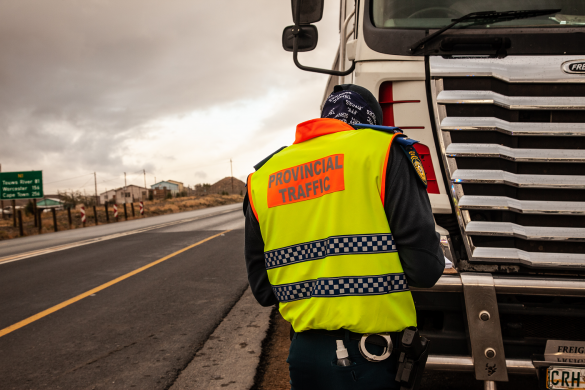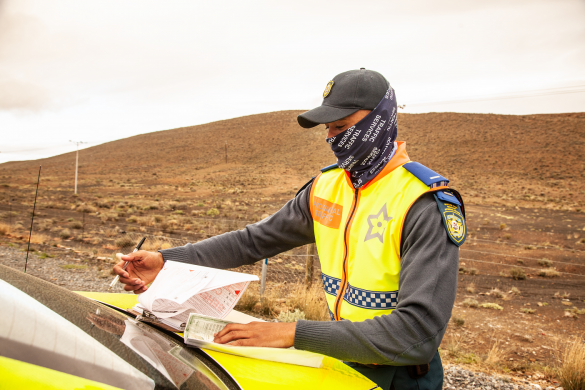Western Cape Provincial Traffic Services implemented a total of 171 integrated roadblocks, vehicle checkpoint and speed control operations across the province in the week of 17 to 23 May 2021, and 19 993 vehicles were stopped and checked.
A total of 379 speeding offences were recorded and 3 522 fines were issued for various traffic violations ranging from driver to vehicle fitness in the total amount of R3 117 000.
Seven vehicles were impounded and 55 were discontinued for unroadworthiness.
The highest speeds recorded were as follows:
- 160 km/h in a 120 km/h zone
- 144 km/h in a 100 km/h zone
- 124 km/h in a 80 km/h zone
- 99 km/h in a 60 km/h zone
Disaster Management Act
A total of eight charges were laid under the Disaster Management Act and fines to the total value of R22 500 were issued.
National Road Traffic Act, Criminal Procedure Act and COVID-19 regulations
A total of 37 arrests were made for the following offences:
- 16 x driving under the influence of alcohol
- 6 x speeding
- 6 x possession of fraudulent documentation
- 2 x reckless and negligent driving
- 3 x goods overloading
- 1 x bribery
- 1 x no driver’s licence
- 1 x crimen injuria
- 1 x endangering an officer’s life (COVID-19 regulations)
Fatalities recorded between 17 to 23 May 2021
A total of 18 crashes occurred in the reporting period, and 21 fatalities were recorded:
- 3 x drivers
- 2 x motorcyclists
- 3 x passengers
- 13 x pedestrians
No text or call is worth your life – it can wait
“Taking your eyes off the road for any reason while you are driving is extremely dangerous. Distracted driving is one of the leading causes of crashes that kill people and leave them seriously injured,” says Vigie Chetty, Acting Director: Traffic Law Enforcement. “Never look away to answer a call, check a message or adjust the music – it’s like driving with your eyes closed. Even talking, eating or drinking can take your attention away from driving safely. No text or call is worth risking your life or the life of others – it can wait,” she adds.
We are heading into winter, and rain, mist and fog are already reducing visibility on the roads. Ensure your headlamps, rear lamps, stop lamps and brakes are working. Make sure your tyres are in a good condition so that you can safely drive in winter road conditions. Take careful note of pedestrians, cyclists and motorcyclists.
Distracted pedestrians are a danger to themselves and to other people on the road. Only walk where it is safe to do so. Wear visible clothing, especially at night. Motorists can only avoid you if they can see you. When you cross a road, pay careful attention to the traffic. Take off your earphones or headphones so that you can hear oncoming traffic. If you have been drinking, avoid walking near a road. Find a safer way to get home.
Never drink and drive. Even small amounts of alcohol can affect your judgement as a driver or a cyclist. Do not drive or cycle when you have been drinking. Make other arrangements to get home. If you are stopped by a traffic law enforcement officer and the officer suspects that you are over the legal limit, you will be arrested. If you are convicted of driving under the influence of alcohol, you will have a criminal record. Driving tired is as dangerous as driving drunk. The urge to sleep can distract you from driving safely. If you are tired, pull over and rest. On a long journey, plan to take rest breaks in safe places every two hours or 200 km.
If you drive a public transport vehicle, be extra careful throughout your journey. Ensure the safety of your passengers at all times. If you experience a breakdown, never allow your passengers to get out of the vehicle into the roadway because this will endanger their lives. Make sure your vehicle is roadworthy and that your operating licence is in order. Ensure that you and all occupants are wearing a mask over their noses and mouths, and sanitising regularly. Stay off the road during the curfew hours between midnight and 04:00.
Observe passenger limits – 100% of licensed carrying capacity for journeys shorter than 200 km, and 70% of carrying capacity for journeys of more than 200 km. Make sure the windows are at least 5 cm open on both sides of your vehicle at all times. The Department of Transport and Public Works uses electronic systems to monitor public transport vehicles, drivers, and trips. The details of operating licences are available to traffic officers in real-time. Tired drivers will be pulled off and made to rest before they resume their onward journeys. Never speed. Speeding drivers risk the lives of the people in their vehicles, and the lives of others. It is best to travel slowly and carefully. It’s the only way that you will be able to react to emergencies in time.
Seatbelts save lives. If a vehicle travelling at only 60 km/h crashes, a 55 kg person without a seatbelt will experience an impact of over 19 000 kg! With a seatbelt, the force will be about 3 800 kg. Always wear a seatbelt, even on the shortest trip. Make sure everyone in your vehicle is using a seatbelt or age-appropriate child harness.
No text or call is worth your life – it can wait. For more information see safelyhome.westerncape.gov.za and find us on Facebook and Twitter @WCGovSafelyHome.
Media enquiries
Jandré Bakker
Head of Communication
Department of Transport and Public Works
Email: Jandre.Bakker@westerncape.gov.za


